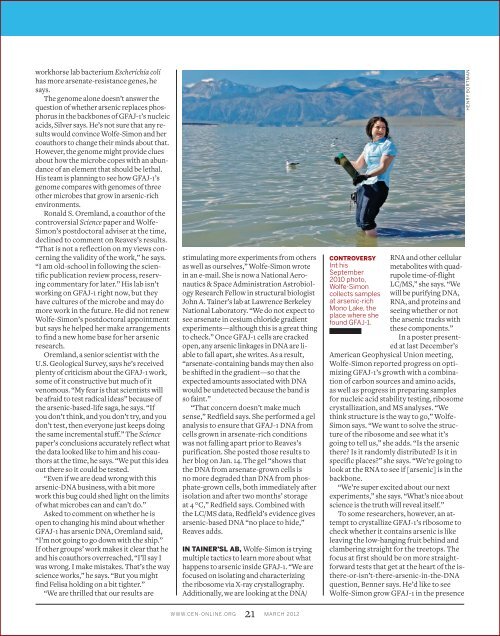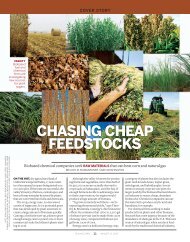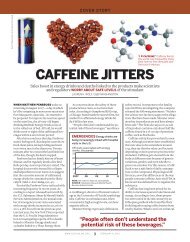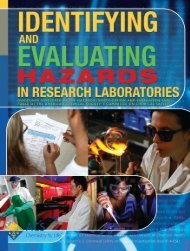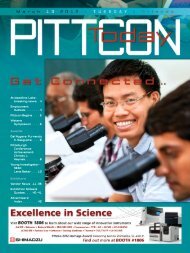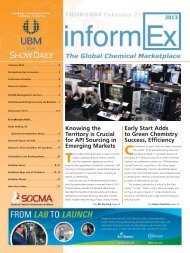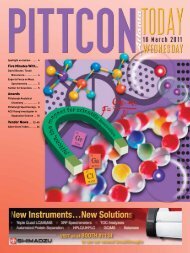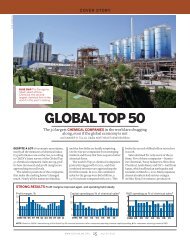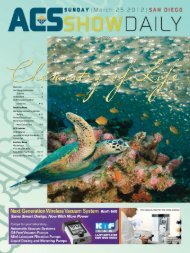focus on life sciences - Chemical & Engineering News - American ...
focus on life sciences - Chemical & Engineering News - American ...
focus on life sciences - Chemical & Engineering News - American ...
- No tags were found...
You also want an ePaper? Increase the reach of your titles
YUMPU automatically turns print PDFs into web optimized ePapers that Google loves.
workhorse lab bacterium Escherichia colihas more arsenate-resistance genes, hesays.The genome al<strong>on</strong>e doesn’t answer thequesti<strong>on</strong> of whether arsenic replaces phosphorusin the backb<strong>on</strong>es of GFAJ-1’s nucleicacids, Silver says. He’s not sure that any resultswould c<strong>on</strong>vince Wolfe-Sim<strong>on</strong> and hercoauthors to change their minds about that.However, the genome might provide cluesabout how the microbe copes with an abundanceof an element that should be lethal.His team is planning to see how GFAJ-1’sgenome compares with genomes of threeother microbes that grow in arsenic-richenvir<strong>on</strong>ments.R<strong>on</strong>ald S. Oremland , a coauthor of thec<strong>on</strong>troversial Science paper and Wolfe-Sim<strong>on</strong>’s postdoctoral adviser at the time,declined to comment <strong>on</strong> Reaves’s results.“That is not a reflecti<strong>on</strong> <strong>on</strong> my views c<strong>on</strong>cerningthe validity of the work,” he says.“I am old-school in following the scientificpublicati<strong>on</strong> review process, reservingcommentary for later.” His lab isn’tworking <strong>on</strong> GFAJ-1 right now, but theyhave cultures of the microbe and may domore work in the future. He did not renewWolfe-Sim<strong>on</strong>’s postdoctoral appointmentbut says he helped her make arrangementsto find a new home base for her arsenicresearch.Oremland, a senior scientist with theU.S. Geological Survey, says he’s receivedplenty of criticism about the GFAJ-1 work,some of it c<strong>on</strong>structive but much of itvenomous. “My fear is that scientists willbe afraid to test radical ideas” because ofthe arsenic-based-<strong>life</strong> saga, he says. “Ifyou d<strong>on</strong>’t think, and you d<strong>on</strong>’t try, and youd<strong>on</strong>’t test, then every<strong>on</strong>e just keeps doingthe same incremental stuff.” The Sciencepaper’s c<strong>on</strong>clusi<strong>on</strong>s accurately reflect whatthe data looked like to him and his coauthorsat the time, he says. “We put this ideaout there so it could be tested.“Even if we are dead wr<strong>on</strong>g with thisarsenic-DNA business, with a bit morework this bug could shed light <strong>on</strong> the limitsof what microbes can and can’t do.”Asked to comment <strong>on</strong> whether he isopen to changing his mind about whetherGFAJ-1 has arsenic DNA, Oremland said,“I’m not going to go down with the ship.”If other groups’ work makes it clear that heand his coauthors overreached, “I’ll say Iwas wr<strong>on</strong>g. I make mistakes. That’s the wayscience works,” he says. “But you mightfind Felisa holding <strong>on</strong> a bit tighter.”“We are thrilled that our results arestimulating more experiments from othersas well as ourselves,” Wolfe-Sim<strong>on</strong> wrotein an e-mail. She is now a Nati<strong>on</strong>al Aer<strong>on</strong>autics& Space Administrati<strong>on</strong> AstrobiologyResearch Fellow in structural biologistJohn A. Tainer ’s lab at Lawrence BerkeleyNati<strong>on</strong>al Laboratory . “We do not expect tosee arsenate in cesium chloride gradientexperiments—although this is a great thingto check.” Once GFAJ-1 cells are crackedopen, any arsenic linkages in DNA are liableto fall apart, she writes. As a result,“arsenate-c<strong>on</strong>taining bands may then alsobe shifted in the gradient—so that theexpected amounts associated with DNAwould be undetected because the band isso faint.”“That c<strong>on</strong>cern doesn’t make muchsense,” Redfield says. She performed a gelanalysis to ensure that GFAJ-1 DNA fromcells grown in arsenate-rich c<strong>on</strong>diti<strong>on</strong>swas not falling apart prior to Reaves’spurificati<strong>on</strong>. She posted those results toher blog <strong>on</strong> Jan. 14. The gel “shows thatthe DNA from arsenate-grown cells isno more degraded than DNA from phosphate-growncells, both immediately afterisolati<strong>on</strong> and after two m<strong>on</strong>ths’ storageat 4 °C,” Redfield says. Combined withthe LC/MS data, Redfield’s evidence givesarsenic-based DNA “no place to hide,”Reaves adds.IN TAINER’S L AB, Wolfe-Sim<strong>on</strong> is tryingmultiple tactics to learn more about whathappens to arsenic inside GFAJ-1. “We are<str<strong>on</strong>g>focus</str<strong>on</strong>g>ed <strong>on</strong> isolating and characterizingthe ribosome via X-ray crystallography.Additi<strong>on</strong>ally, we are looking at the DNA/CONTROVERSYIn t hisSeptember2010 photo,Wolfe-Sim<strong>on</strong>collects samplesat arsenic-richM<strong>on</strong>o Lake, theplace where shefound GFAJ-1.RNA and other cellularmetabolites with quadrupoletime-of-flightLC/MS,” she says. “Wewill be purifying DNA,RNA, and proteins andseeing whether or notthe arsenic tracks withthese comp<strong>on</strong>ents.”In a poster presentedat last December’s<strong>American</strong> Geophysical Uni<strong>on</strong> meeting ,Wolfe-Sim<strong>on</strong> reported progress <strong>on</strong> optimizingGFAJ-1’s growth with a combinati<strong>on</strong>of carb<strong>on</strong> sources and amino acids,as well as progress in preparing samplesfor nucleic acid stability testing, ribosomecrystallizati<strong>on</strong>, and MS analyses. “Wethink structure is the way to go,” Wolfe-Sim<strong>on</strong> says. “We want to solve the structureof the ribosome and see what it’sgoing to tell us,” she adds. “Is the arsenicthere? Is it randomly distributed? Is it inspecific places?” she says. “We’re going tolook at the RNA to see if [arsenic] is in thebackb<strong>on</strong>e.“We’re super excited about our nextexperiments,” she says. “What’s nice aboutscience is the truth will reveal itself.”To some researchers, however, an attemptto crystallize GFAJ-1’s ribosome tocheck whether it c<strong>on</strong>tains arsenic is likeleaving the low-hanging fruit behind andclambering straight for the treetops. The<str<strong>on</strong>g>focus</str<strong>on</strong>g> at first should be <strong>on</strong> more straightforwardtests that get at the heart of the isthere-or-isn’t-there-arsenic-in-the-DNAquesti<strong>on</strong>, Benner says. He’d like to seeWolfe-Sim<strong>on</strong> grow GFAJ-1 in the presenceHENRY BORTMANWWW.CEN-ONLINE.ORG 21 MARCH 2012


